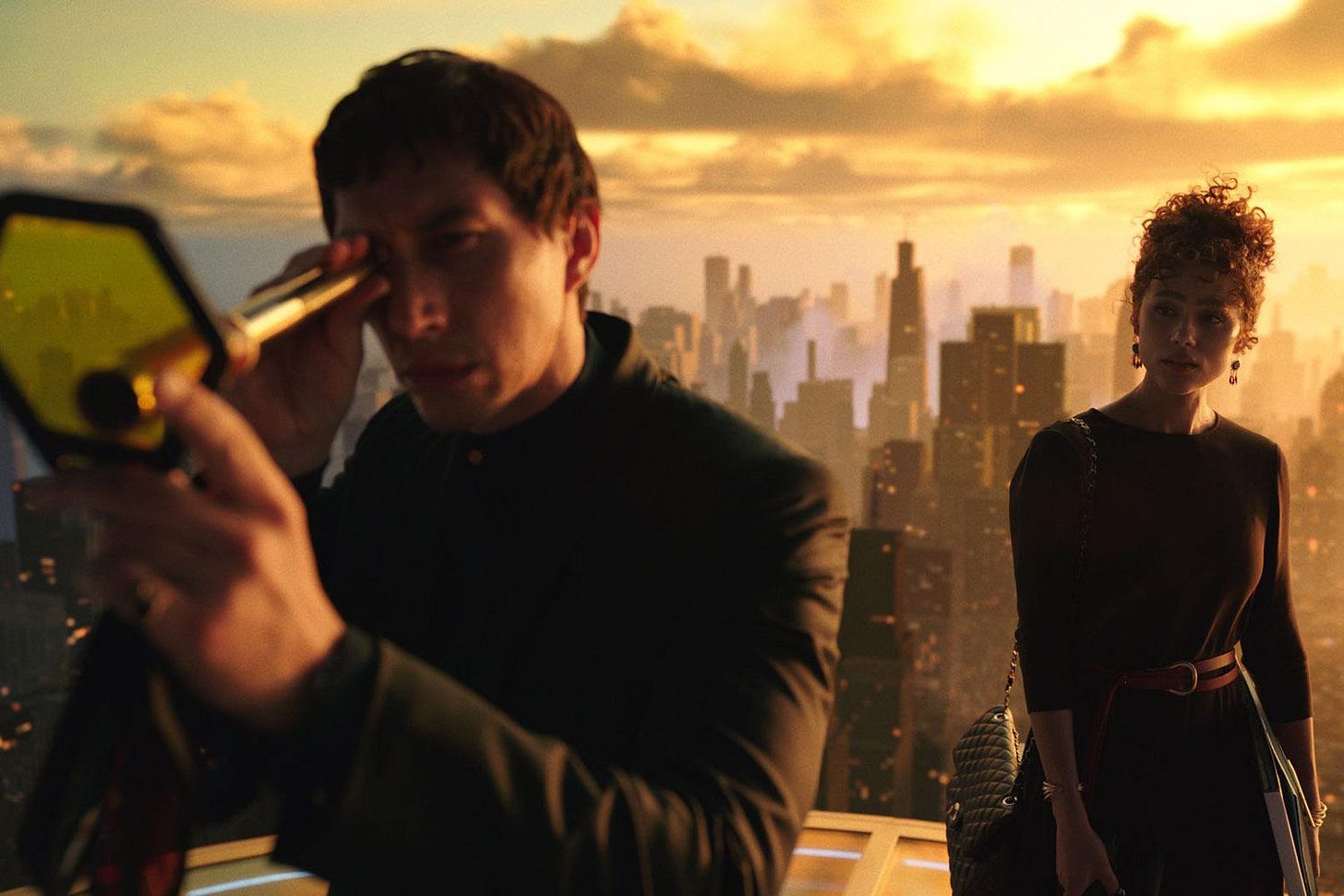Megalopolis teems with contradictions: it’s a $120 million DIY vanity project, both personal and wildly excessive, maudlin and debaucherous. Along with the film come many of the flaws we might expect from something like this: a penchant for messiness and self-indulgence, half-baked ideas, a tone that ricochets from one extreme to another. More important, I think, are the attributes of such a unique project: Megalopolis is thoughtful, ambitious, carnivalesque, one-of-a-kind. It feels more alive than any other American movie released over the last few years.
Its underlying concept is simple, even if the final creation is not: the fall of the American empire, mirroring the collapse of ancient Rome. Essentially, three public figures go head-to-head in “New Rome” (as New York is known here), with each of the three broadly representing political frameworks: there’s brilliant scientist Cesar Catilina (Adam Driver), whose new invention of “megalon”—a building material that defies the laws of physics, space, and time—paves the way for his envisioned utopia; Mayor Franklyn Cicero (Giancarlo Esposito), a pragmatic leader focused on solving the dire issues currently facing his constituents; and demagogue Clodio Pulcher (Shia LaBeouf), Catilina’s vengeful cousin, who exploits the frustrations of the impoverished and oppressed to plot his ascendance to power. As the son of billionaire banker Hamilton Crassus III (Jon Voight), Clodio is clearly associated with the world of stratospheric wealth; Cesar and Cicero, meanwhile, could be said to symbolize art and innovation in the first case, and the everyday workings of democracy in the second.
Though Francis Ford Coppola had famously been conceiving of Megalopolis for decades (Laurence Fishburne, who appears here as Catilina’s assistant and the film’s narrator, remembers Coppola discussing it during the making of Apocalypse Now), much of it still feels half-realized. Starting with the film’s political allusions, Megalopolis is often both vague and obvious in its commentary on the modern American state—though it’s a sad irony that most of the points Coppola wanted to make in the 1980s still apply (more forcefully) in 2024. Concepts of utopianism, realpolitik, and despotism are painted in broad strokes, and the way these forces commingle in Megalopolis reeks of idealism, especially in a maudlin ending. The parallels between these characters and real-life American figures are frustratingly unclear: Crassus and Clodio are fairly obvious echoes of Donald Trump Sr. and Jr., but Cicero might represent any neoliberal leader of the last four decades, and Cesar is the kind of glorious Renaissance man that hasn’t existed in real life since…well, the Renaissance. (His megalomaniacal need to create and ideate suggests someone like Elon Musk, but without the pathetic wannabe fascism.) In other words, there’s not a lot of depth to glean from Coppola’s fanciful political commentary, but the fact that Megalopolis leads to a discussion about demagogues and realpolitik is something to savor in itself.
The same could be said for the film’s overstuffed plot, which basically sees Coppola hurling every idea against the wall to see what sticks. There’s a star-crossed romance subplot, as Cesar falls in love with Cicero’s spoiled socialite daughter, Julia (Nathalie Emmanuel); their relationship depends on some outdated tropes about women being inspirational muses waiting in the wings behind their brilliant male partners, but there’s poignancy in Cesar and Julia’s relationship, an attempt at paradise in a cold, calculating world. (Much of the credit goes to Driver and Emmanuel, who may not always convey Coppola’s dialogue believably but still embody ideals like hope and human connection.) There’s a pseudo-mystery backstory revolving around the death of Cesar’s first wife, who drowned in a mysterious car accident; after two viewings of Megalopolis, I still can’t tell you exactly what happened in this narrative strand. There’s an entertainment journalist (Aubrey Plaza) who schemes to become rich and powerful, a virginal pop superstar (Grace VanderWaal) who’s held to ridiculous standards of femininity, a meteor shower that plunges New Rome into chaos eerily reminiscent of 9/11. Coppola’s intent was clearly to make a sprawling, anything-goes epic that tries to encapsulate modern America’s late-capitalist, late-democracy fragility.
No surprise that Megalopolis has already proved divisive, a feat that Coppola seems to wear as a badge of honor. (In the live interview with Coppola, Robert De Niro, Spike Lee, and Dennis Lim that preceded Megalopolis’s New York Film Festival premiere, Coppola boasted that the last of his films to receive such a response was the now-revered Apocalypse Now.) Each viewer’s enthusiasm for the movie will depend on what you look for in cinema in the first place: if you crave tight stories, tasteful entertainment, a momentary diversion, then Megalopolis will prove exasperating and silly; if, on the other hand, you still think cinema can be a place of ambition, artistry, philosophy, personality, then Coppola’s latest is something to embrace.
Diverse opinions make for lively discourse—something Megalopolis sees as a utopian part of civilization (and something increasingly rare in American society)—but I find myself frustrated by some of the film’s scathing reviews. It’s flawed, certainly, and moments of humor (intentional or otherwise) crop up at the least opportune moments; it’s embarrassingly earnest and overeager to prove its own significance. But it’s also glittering with creativity, ideas, richness, and humanity, not to mention eye-popping visuals (see it in IMAX if you can) courtesy of Mihai Mălaimare, Jr. and Ron Fricke. (Coppola shot some footage with Fricke, who lensed Koyaanisqatsi and directed Baraka and Samsara, in the early 2000s; some of this on-the-ground footage of New York, with silky night skies and hulking skyscrapers, is Megalopolis’s loveliest.) The lush soundtrack, too, by Osvaldo Golijav reenforces the idea that Megalopolis is a modern-day opera, teetering on the border between camp and sophistication.
To put it another way, Megalopolis is a much-needed oddity for movie lovers worn down by Marvel films and streaming platforms—a relic of a time when filmmakers had something to say and used all the tools of cinema as their canvas. Some of the criticism surrounding Megalopolis is focused on its recent negative publicity: accusations of sexual harassment by Coppola onset, fake critics’ quotes on marketing materials, Coppola’s career arc more generally. (I don’t love most of his recent movies, but it’s foolish to dismiss all of them as the sad denouement of a great director’s filmography.) The tendency to judge something based on its widespread online reputation is one of the marks of thoughtlessness that Megalopolis would surely decry—so maybe it’s appropriate that the movie itself is meeting the same fate, at least in some circles. But I’d rather embrace Megalopolis for what it is: a messy, dazzling, outlandish work from an artist instead of a content creator. It can barely be contained onscreen—in fact, sometimes it expands to an opulent triptych format (à la Abel Gance’s Napoléon from 1927) or shrinks its image to one-sixth of the screen size, as if such wild flights of fancy can’t abide by the rigid contours of the typical frame. It’s campy, ridiculous, often very funny, but utterly devoid of irony and cynicism. It is, in 2024, that rarest thing: a momentous reason to go to the theater and prepare yourself for something you won’t see anywhere else.




